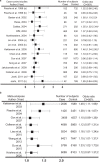TGFBR1*6A as a modifier of breast cancer risk and progression: advances and future prospects
- PMID: 35853889
- PMCID: PMC9296458
- DOI: 10.1038/s41523-022-00446-6
TGFBR1*6A as a modifier of breast cancer risk and progression: advances and future prospects
Abstract
There is growing evidence that germline mutations in certain genes influence cancer susceptibility, tumor evolution, as well as clinical outcomes. Identification of a disease-causing genetic variant enables testing and diagnosis of at-risk individuals. For breast cancer, several genes such as BRCA1, BRCA2, PALB2, ATM, and CHEK2 act as high- to moderate-penetrance cancer susceptibility genes. Genotyping of these genes informs genetic risk assessment and counseling, as well as treatment and management decisions in the case of high-penetrance genes. TGFBR1*6A (rs11466445) is a common variant of the TGF-β receptor type I (TGFBR1) that has a global minor allelic frequency (MAF) of 0.051 according to the 1000 Genomes Project Consortium. It is emerging as a high frequency, low penetrance tumor susceptibility allele associated with increased cancer risk among several cancer types. The TGFBR1*6A allele has been associated with increased breast cancer risk in women, OR 1.15 (95% CI 1.01-1.31). Functionally, TGFBR1*6A promotes breast cancer cell proliferation, migration, and invasion through the regulation of the ERK pathway and Rho-GTP activation. This review discusses current findings on the genetic, functional, and mechanistic associations between TGFBR1*6A and breast cancer risk and proposes future directions as it relates to genetic association studies and mechanisms of action for tumor growth, metastasis, and immune suppression.
© 2022. The Author(s).
Conflict of interest statement
The authors declare no competing interests.
Figures



Similar articles
-
TGFBR1*6A is a potential modifier of migration and invasion in colorectal cancer cells.Oncol Lett. 2018 Mar;15(3):3971-3976. doi: 10.3892/ol.2018.7725. Epub 2018 Jan 4. Oncol Lett. 2018. PMID: 29467907 Free PMC article.
-
TGFBR1*6A enhances the migration and invasion of MCF-7 breast cancer cells through RhoA activation.Cancer Res. 2008 Mar 1;68(5):1319-28. doi: 10.1158/0008-5472.CAN-07-5424. Cancer Res. 2008. PMID: 18316594 Free PMC article.
-
The TGFBR1*6A allele is not associated with susceptibility to colorectal cancer in a Spanish population: a case-control study.BMC Cancer. 2009 Jun 18;9:193. doi: 10.1186/1471-2407-9-193. BMC Cancer. 2009. PMID: 19538729 Free PMC article.
-
TGFBR1 signaling and breast cancer.J Mammary Gland Biol Neoplasia. 2011 Jun;16(2):89-95. doi: 10.1007/s10911-011-9216-2. Epub 2011 Apr 5. J Mammary Gland Biol Neoplasia. 2011. PMID: 21461994 Free PMC article. Review.
-
Li-Fraumeni syndrome: not a straightforward diagnosis anymore-the interpretation of pathogenic variants of low allele frequency and the differences between germline PVs, mosaicism, and clonal hematopoiesis.Breast Cancer Res. 2019 Sep 18;21(1):107. doi: 10.1186/s13058-019-1193-1. Breast Cancer Res. 2019. PMID: 31533767 Free PMC article. Review.
Cited by
-
Bidirectional Mendelian randomization and potential mechanistic insights into the causal relationship between gut microbiota and malignant mesothelioma.Medicine (Baltimore). 2025 Apr 25;104(17):e42245. doi: 10.1097/MD.0000000000042245. Medicine (Baltimore). 2025. PMID: 40295238 Free PMC article.
References
Publication types
LinkOut - more resources
Full Text Sources
Research Materials
Miscellaneous

